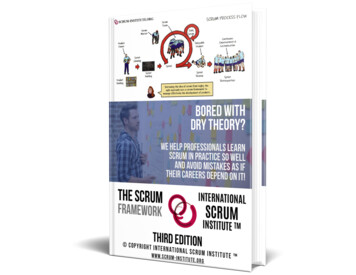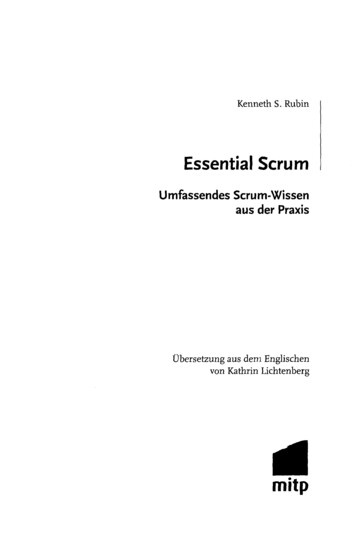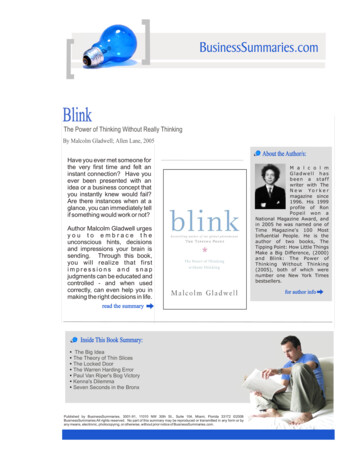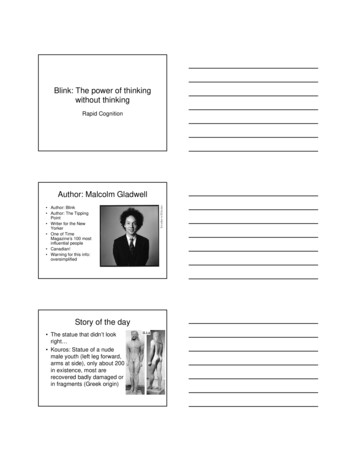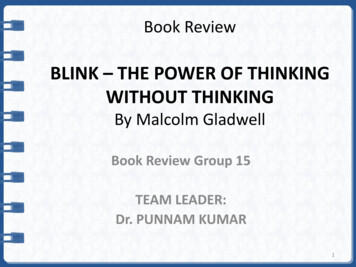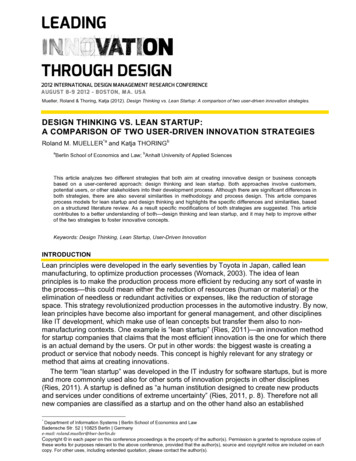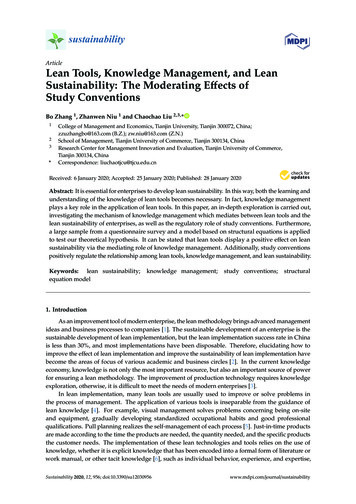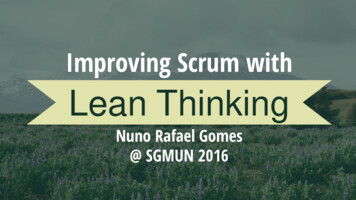
Transcription
Improving Scrum withLean ThinkingNuno Rafael Gomes@ SGMUN 2016
m/in/nrgomesA Product Owner in contact with Industry since 2003
1Once upon a time in a company far, far away with the help of Geek & Poke
“Sometimes we win,sometimes we learn.”Nuno Rafael Gomes, adapted from John Maxwell
2ScrumScrum is simple, but not easy.
“You have to learnthe rules of the game.”Albert Einstein
Agile for All
Henrik Kniberg
Product OwnerDevelopmentTeamScrum Master
Build theright thing.Build thething right.Learn fast toadapt faster.
“Any fool can know.The point is to understand.”Albert Einstein
3Lean Thinking PrinciplesAlways start from need.
5. SeekPerfection4.EstablishPull1. IdentifyValueClassicalLean ThinkingPrinciples3. CreateFlow2. Map theValueStream
7. Engagethe future(foresight)6. SeekPerfection1. IdentifyCustomersLean ThinkingPrinciples(my own)2. SpecifyValue(s)3. MapValueStream(s)5. EstablishPull4. CreateFlow(s)
#1Find out who your customers are.
#2Specify value from the standpoint ofthe end customer, by product family.
#3Identify all the steps in the valuestream for each product family,eliminating those steps that do notcreate value whenever possible.
#4Make the value-creating steps occurin tight sequence, so that the productwill flow smoothly towards thecustomer.
#5As flow is introduced, let customerspull value from the next upstreamactivity.
#6Retrospect frequently with the goal toachieve perfection in which perfectvalue is created with no waste.
#7Take time to foresight the future:forecasting, forward thinking,strategic analysis, priority setting
4The Toyota WayA winning Management Philosophy.
Pillars & ValuesLearn more about the Toyota Way at Toyota or Wikipedia.
Respect for PeopleRespectWe respect others, make every effort to understand each other,take responsibility and do our best to build mutual trust.
Respect for PeopleTeamworkWe stimulate personal and professional growth,share the opportunities of developmentand maximize individual and team performance.
Continuous ImprovementChallengeWe form a long-term vision, meeting challengeswith courage and creativity to realize our dreams.
Continuous ImprovementKaizenWe improve our business operations continuously,always driving for innovation and evolution.
Continuous ImprovementGenchi GenbutsuWe go to the source to find the facts to make correct decisions.
5Toyota Thinking PrinciplesThinking People System (TPS)
Toyota 4 P’sPhilosophyProcess Long Term Thinking Elminate WastePeople & PartnersProblem Solving Respect, Challenge & Grow Them Continuous Improvement & Learning
Long-term Philosophy
PhilosophyPrinciple #1Base your management decisions on a long-term philosophy,even at the expense of short-term financial goals.
PhilosophyPrinciple #1Base your management decisions on a long-term philosophy,even at the expense of short-term financial goals.People need purpose to find motivation & stablish goals.
The right process will alwaysproduce the right results.
ProcessPrinciple #2Create continuous process flow to bring problems to the surface.
ProcessPrinciple #2Create continuous process flow to bring problems to the surface.Move toward flow.Move to ever-smaller batch sizes and cycle times to deliver value fast and to expose weakness and hidden problems.
ProcessPrinciple #3Use pull systems (JIT, Kanban) to avoid over-production.
ProcessPrinciple #3Use pull systems (JIT, Kanban) to avoid over-production.Pull is a Production Order initiated by a Customer Order (JIT).Kanban is an workflow management system that helps JIT work.We should only produce what is needed by the Customer.Watch the baton (work), not the runners (workers).
ProcessPrinciple #4Level out the workload (Heijunka) for build to order (JIT).Work like the tortoise, not the hare.
ProcessPrinciple #4Level out the workload (Heijunka) for build to order (JIT).Work like the tortoise, not the hare.This helps achieve the goal of minimizing waste (muda),not overburdening people or the equipment (muri),and not creating uneven production levels (mura).
ProcessPrinciple #5Build a culture of stopping to fix problems (Jidoka), to buildquality in (process, product) and get quality right from the first.
ProcessPrinciple #5Build a culture of stopping to fix problems (Jidoka), to buildquality in (process, product) and get quality right from the first.Quality always takes precedence (Jidoka).Machines should automatically stop in case of an error (Poka-Yoke)Any employee has the authority to stop the line to warnfor a quality issue using visual signage (Andon).
ProcessPrinciple #6Standardize work for continuous improvementand employee empowerment (Kaizen).
ProcessPrinciple #6Standardize work for continuous improvementand employee empowerment (Kaizen).People doing the work should own their processes.Give them time (buffer) to improve their processes.Use the Paretto rule: 80% working, 20% improving.
ProcessPrinciple #7Use visual controls so that no problems are hidden and to coordinate.
ProcessPrinciple #7Use visual controls so that no problems are hidden and to coordinate.Use Kanban boards to visualize the work.Use Kanban cards to coordinate the supply chain.
ProcessPrinciple #8Use only reliable, thoroughly-tested technologythat serves your people and your processes.
ProcessPrinciple #8Use only reliable, thoroughly-tested technologythat serves your people and your processes.Technology is pulled by people doing the work not pushed by others.People do work, computers move info: humans are more flexible.
Add value to the organizationby developing your People & Partners.
People & PartnersPrinciple #9Grow leaders from within, who thoroughly understand the work,live the philosophy, and teach it to others.
People & PartnersPrinciple #9Grow leaders from within, who thoroughly understand the work,live the philosophy, and teach it to others.Toyota don’t go for head hunting: they don’t know The Toyota Way.
People & PartnersPrinciple #10Develop exceptional people and teamswho follow your company's philosophy.
People & PartnersPrinciple #10Develop exceptional people and teamswho follow your company's philosophy.Employees must be educated and trained:they have to maintain a learning organization.Success is based on the team, not the individual.Teams should be small (3-7 people).
People & PartnersPrinciple #11Respect your extended network of partners,by challenging them and helping them improve.
People & PartnersPrinciple #11Respect your extended network of partners,by challenging them and helping them improve.Treat your suppliers much like you treat your employees.Provide cross functional teams to help them discover and fix problemsso that they can become stronger and better partners.
Continuously solving root problemsdrives organizational learning.
Problem SolvingPrinciple #12Go and see for yourself the real workplace (Genchi Genbutsu)to thoroughly understand the situation and help.
Problem SolvingPrinciple #12Go and see for yourself the real workplace (Genchi Genbutsu)to thoroughly understand the situation and help.Managers are expected to "go-and-see" operations.Only experiencing the situation firsthand, managers will havean understanding of how operations can be improved.
Problem SolvingPrinciple #13Make decisions slowly by consensus, thoroughly consideringall options (Nemawashi); implement decisions rapidly.
Problem SolvingPrinciple #13Make decisions slowly by consensus, thoroughly consideringall options (Nemawashi); implement decisions rapidly.Always seek for the underlying root cause.Always consider a broad range of alternatives.Build consensus around the resolution.
Problem SolvingPrinciple #14Become a learning organization through relentlessreflection (Hansei) and continuous improvement (Kaizen).
Problem SolvingPrinciple #14Become a learning organization through relentlessreflection (Hansei) and continuous improvement (Kaizen).The process of becoming a learning organizationinvolves criticizing every aspect of what one does.Always clarify the problem first!Next use a Root Cause Analysis technique (A3 Report).Finally, countermeasure, evaluate and standardize.
6ValueMoney flows in the direction of Value.
“Price is what you pay.Value is what you get.”Warren Buffet
“Lean thinking defines value asproviding benefit to the customer;anything else is waste.”Eric Ries
What is a value-added activity?The activitymusttransformthe product/ service.Thecustomermust bewilling topay for it.It mustbe donecorrectlyfirst time.
7WasteThe most dangerous is the one you don’t see.
DefectsExtra-processingMotionOver-productionMuda Non added value!InventoryWaitingNon-used TalentTransportation
DEOMuda DOWNTIMEMIWNT
DefectsThe loss involved in rectifying faulty parts or products.
Over-productionProducing more, sooner or faster than is required bythe next process or the customer needs/specs.
WaitingIdle time created when material, information,people or equipment is not ready.
Non-used TalentEmployee knowledge/skills not being used to their full potential,either on producing value added work, or on identifying waste.
TransportationMoving products around without making any transformationthe customer is willing to pay for.
InventoryHaving more than the minimum stocks necessaryfor a precisely controlled pull system.In other words:Inventory represents a capital outlay that has not yetproduced an income, either by the producer or for the consumer.
MotionPeople making movements that are straining or unnecessary to add value,causing damage to products/people and associated transaction costs.
Extra-processingPerforming unnecessary or incorrect processing.
8Learning CyclesScrum or Lean, they are all the same.
4. Act1. PlanPDCALearning Cycle(Lean)3. Check2. Do
4. Emergeinto Backlog1. PlanningPSR2ELearning Cycle(Scrum)3. Review &Retrospective2. Sprint
9ScrumA proposal for a fresh perspective
“Start from Need.”Taiichi Ohno
“Don't find customers for your products,find products for your customers.”Seth Godin
“Scrum is a framework for developingand sustaining complex products.”Ken Schwaber & Jeff Sutherland
“You've got to startwith the customer experienceand work back toward the technology.Not the other way around.”Steve Jobs
Product OwnerDevelopmentTeamScrum Master
Build theright thing.Build thething right.Learn fast toadapt faster.
Why?How?What?
Why should webuild thisproduct?How do webuild theproduct withquality?What do weneed to do todeliver a greatproduct?
Product OwnerDevelopmentTeamScrum Master
Build theright thing.Build thething right.ContinuouslydevelopPeople.
. To delightcustomers. To powercontinuousinnovation,aka, Kaizen. To enableautonomy,mastery andpurpose.
10Scrum Lean ThinkingA virtuous circle for sustainable growth
“Develop People First,and only then, Products.”Toyota True Mission
5. Engagethe future(foresight)4. DelightCustomers1. Identifythe WhyScrum Lean ThinkingPrinciples3. DevelopProducts2. DevelopPeople
amScrumMaster
Win theheart of vationat all levelsDeveloppeoplecapabilities
”Scrum is a value-driven framework& Lean Thinking helps boost it.”Nuno Rafael Gomes
Thank You!Tweet #SGMUN #Lean #LeanThinking@nrgomes
11Muda WasteExtra slides with links
DefectsThe loss involved in rectifying faulty parts or products.
DefectsThe loss involved in rectifying faulty parts or products.Examples:Scrap, defects, bugs.Rework, bug fixing.Missing parts/features.Effort involved in inspecting for and fixing defects.
DefectsThe loss involved in rectifying faulty parts or products.Common causes:Mismatched production rates.Batch processing, inspect-in quality.Process failures, machine breakdowns.
DefectsThe loss involved in rectifying faulty parts or products.Countermeasures:Implement Standard Work.Use mistake-proofing devices (Poka-Yoke).Implement a single-piece flow strategy (WIP 1).Implement automation w/ human intelligence (Jidoka, Autonomation).
Over-productionProducing more, sooner or faster than is required bythe next process or the customer needs/specs.
Over-productionProducing more, sooner or faster than is required bythe next process or the customer needs/specs.Examples:Producing more to avoid setups.Producing extra functionalities/features.Batch processing, resulting in extra output.Producing product to stock, based on sales forecasts.
Over-productionProducing more, sooner or faster than is required bythe next process or the customer needs/specs.Common causes:Long machine setups.Too much Forecasting.“Just-in-case” for breakdowns.
Over-productionProducing more, sooner or faster than is required bythe next process or the customer needs/specs.Countermeasures:Level/smooth the Production (Heijunka).Implement SMED (Single-Minute Exchange of Die) on machines.Implement Just-in-time, aka, JIT, a pull system scheduling strategy.
WaitingIdle time created when material, information,people or equipment is not ready.
WaitingIdle time created when material, information,people or equipment is not ready.Examples:Waiting for machines to run or cycle.Waiting for others, for parts, for inspection.Waiting for information, instructions, decisions.Waiting for machine maintenance to be performed.Waiting for emails to be answered, meetings to start
WaitingIdle time created when material, information,people or equipment is not ready.Common causes:Push Production.Work imbalance.Centralized inspection.Lack of priorities or communication.
WaitingIdle time created when material, information,people or equipment is not ready.Countermeasures:Implement Takt Time on Production.Level/smooth Production (Heijunka).Implement Just-in-time, aka, JIT, a pull system scheduling strategy.
Non-used TalentEmployee knowledge/skills not being used to their full potential,either on producing value added work, or on identifying waste.
Non-used TalentEmployee knowledge/skills not being used to their full potential,either on producing value added work, or on identifying waste.Examples:High skilled workers doing relatively easy jobs.Firefighting all the time instead of focusing on Kaizen.Not inviting Experts to the Value Stream Mapping events.
Non-used TalentEmployee knowledge/skills not being used to their full potential,either on producing value added work, or on identifying waste.Common causes:Disrespect for People.Lack of knowledge/skills.Control & Command Culture.
Non-used TalentEmployee knowledge/skills not being used to their full potential,either on producing value added work, or on identifying waste.Countermeasures:Provide Training to all employees.Enforce “all employees are Thinkers” mentality!Implement the 5 Whys technique for problem solving.Start by building consensus (Nemawashi) on decision making processes.
TransportationMoving products around without making any transformationthe customer is willing to pay for.
TransportationMoving products around without making any transformationthe customer is willing to pay for.Examples:Task switching.Handoffs of pieces of work.Paperwork between departments.Moving parts in and out of storage.Product movements between workstations.Digital processes between multiple individuals.
TransportationMoving products around without making any transformationthe customer is willing to pay for.Common causes:Push Production.Batch Production.Poor Production layout.
TransportationMoving products around without making any transformationthe customer is willing to pay for.Countermeasures:Draw Spaghetti charts to visualize flows.Implement Flow lines/cells to optimize flows.Implement the 5S practices on your workplace.Implement Just-in-time, aka, JIT, a pull system scheduling strategy.
InventoryHaving more than the minimum stocks necessaryfor a precisely controlled pull system.In other words:Inventory represents a capital outlay that has not yetproduced an income, either by the producer or for the consumer.
InventoryHaving more than the minimum stocks necessaryfor a precisely controlled pull system.Examples:Raw materials in excess.Finished goods not yet delivered or sold.All partially work done, aka, work-in-progress (WIP).
InventoryHaving more than the minimum stocks necessaryfor a precisely controlled pull system.Common causes:Long machine setups.Long Internal lead times.Long Supplier lead times.
InventoryHaving more than the minimum stocks necessaryfor a precisely controlled pull system.Countermeasures:Implement Flow lines/cells to optimize flows.Implement a single-piece flow strategy (WIP 1).Implement internal and external signboards (Kanban).Implement SMED (Single-Minute Exchange of Die) on machines.
MotionPeople making movements that are straining or unnecessary to add value,causing damage to products/people and associated transaction costs.
MotionPeople making movements that are straining or unnecessary to add value,causing damage to products/people and associated transaction costs.Examples:Task switching.Searching for parts, tools, documents.Sorting through materials or work instructions.
MotionPeople making movements that are straining or unnecessary to add value,causing damage to products/people and associated transaction costs.Common causes:Missing tools, items.Unsafe working areas.Poor workstation design.Workplace disorganization.
MotionPeople making movements that are straining or unnecessary to add value,causing damage to products/people and associated transaction costs.Countermeasures:Implement Standard Work.Draw Spaghetti charts to visualize flows.Implement the 5S practices on your workplace.
Extra-processingPerforming unnecessary or incorrect processing.
Extra-processingPerforming unnecessary or incorrect processing.Examples:Re-learning.Awkward tools.Extra validations.Multiple cleaning of parts.Poor process or product design.Over-tight tolerances or quality standards.
Extra-processingPerforming unnecessary or incorrect processing.Common causes:Push systems.Delays between processing.Customer voice not understood.
Extra-processingPerforming unnecessary or incorrect processing.Countermeasures:Draw your Value Stream Maps.Implement a single-piece flow strategy (WIP 1).Redesign your processes with 3P (Production Preparation Process).
“Sometimes we win, sometimes we learn. . Treat your suppliers much like you treat your employees. Provide cross functional teams to help them discover and fix problems so that they can become stronger and better partners. Continuou
